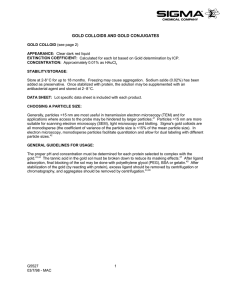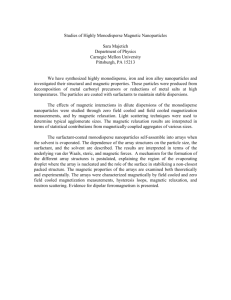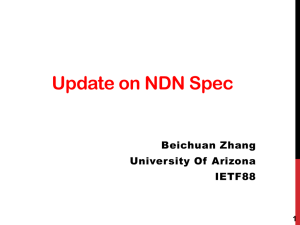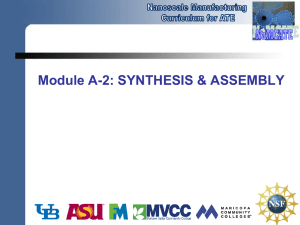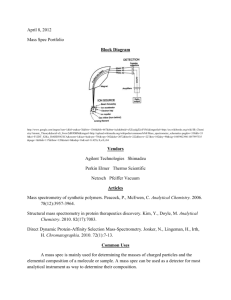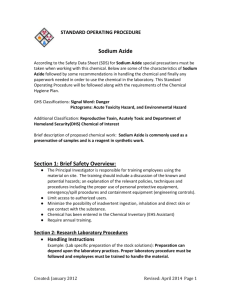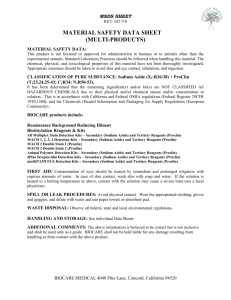Product Information GOLD COLLOIDS AND GOLD CONJUGATES
advertisement
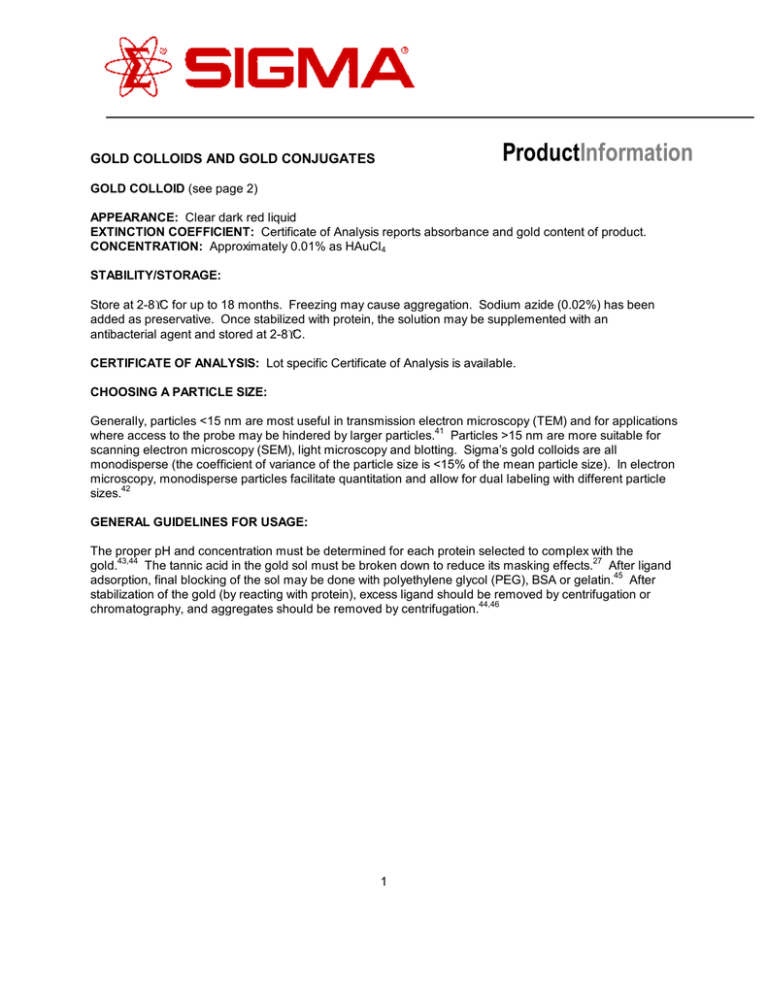
ProductInformation GOLD COLLOIDS AND GOLD CONJUGATES GOLD COLLOID (see page 2) APPEARANCE: Clear dark red liquid EXTINCTION COEFFICIENT: Certificate of Analysis reports absorbance and gold content of product. CONCENTRATION: Approximately 0.01% as HAuCl4 STABILITY/STORAGE: Store at 2-8°C for up to 18 months. Freezing may cause aggregation. Sodium azide (0.02%) has been added as preservative. Once stabilized with protein, the solution may be supplemented with an antibacterial agent and stored at 2-8°C. CERTIFICATE OF ANALYSIS: Lot specific Certificate of Analysis is available. CHOOSING A PARTICLE SIZE: Generally, particles <15 nm are most useful in transmission electron microscopy (TEM) and for applications 41 where access to the probe may be hindered by larger particles. Particles >15 nm are more suitable for scanning electron microscopy (SEM), light microscopy and blotting. Sigma’s gold colloids are all monodisperse (the coefficient of variance of the particle size is <15% of the mean particle size). In electron microscopy, monodisperse particles facilitate quantitation and allow for dual labeling with different particle 42 sizes. GENERAL GUIDELINES FOR USAGE: The proper pH and concentration must be determined for each protein selected to complex with the 43,44 27 The tannic acid in the gold sol must be broken down to reduce its masking effects. After ligand gold. 45 adsorption, final blocking of the sol may be done with polyethylene glycol (PEG), BSA or gelatin. After stabilization of the gold (by reacting with protein), excess ligand should be removed by centrifugation or 44,46 chromatography, and aggregates should be removed by centrifugation. 1 GOLD COLLOIDS AND GOLD CONJUGATES DESCRIPTION: Colloidal gold is an electron-dense, non-fading marker useful as a probe in electron microscopy (TEM and 26 SEM), light microscopy and blotting. It requires no additional processing for detection, but in some 4,40 applications the signal can be enhanced by reaction with silver. It can be complexed with biomolecules 1 by strong, non-covalent interactions. All unconjugated gold colloids offered by Sigma contain about 0.01% HAuCl4 suspended in 0.01% tannic acid with 0.04% trisodium citrate, 0.26 mM potassium carbonate and 0.02% sodium azide as preservative; all are produced by a modified tannic acid method of Slot and 27 Geuze. GOLD COLLOIDS PRODUCT NO. NAME - DESCRIPTION PARTICLE SIZE G-1402 Gold Colloid Spec: 5 nm Mean: 3-6 nm (monodisperse) G-1527 Gold Colloid Spec: 10 nm Mean:8-12 nm (monodisperse) G-1652 Gold Colloid Spec: 20 nm Mean: 17-23 nm (monodisperse) 2 GOLD COLLOIDS AND GOLD CONJUGATES GOLD-ANTIBODY CONJUGATES (see page 4) APPEARANCE: Clear dark red liquid EXTINCTION COEFFICIENT: Certificate of Analysis reports absorbance and gold content of product. STABILITY/STORAGE: Store at 2-8°C for up to 18 months. Sodium azide (0.05%) has been added as preservative. CERTIFICATE OF ANALYSIS: Lot specific Certificate of Analysis is available. CHOOSING A PARTICLE SIZE: Generally, particles <15 nm are most useful in transmission electron microscopy (TEM) and for applications 41 where access to the probe may be hindered by larger particles. Particles >15 nm are more suitable for scanning electron microscopy (SEM), light microscopy and blotting. Sigma’s gold colloids are all monodisperse (the coefficient of variance of the particle size is <15% of the mean particle size). In electron microscopy, monodisperse particles facilitate quantitation and allow for dual labeling with different particle 42 sizes. GENERAL GUIDELINES FOR USAGE: Gold-conjugated antibodies should be diluted for most applications using 0.5 M NaCl buffered at pH 6-8 with 0.1% BSA, 0.05% Tween 20 and 50% fetal bovine serum to minimize background staining. For most applications dilutions may range from A520=1.0-0.05 (1:5-1:100 dilution), Incubation times range from 0.5-12 hours. DESCRIPTION: Gold-antibody conjugates are used to detect antigens and require no additional reagents, unless silver enhancement is used to increase assay sensitivity. These products are typically used as probes in electron 2,3,4 and light microscopy and immunoblotting procedures. All antibodies are conjugated to gold by a 1 modification of Geoghagan’s method. Conjugates are tested for immunoreactivity using the dot blot assay 4 of Brada and Roth. These products are supplied as suspensions in 20% glycerol with 1% BSA, 0.02 M Tris buffered saline, pH 8.0 and 0.05% sodium azide. 3 GOLD COLLOIDS AND GOLD CONJUGATES GOLD-ANTIBODY CONJUGATES PRODUCT NO. NAME - DESCRIPTION HOST ANIMAL G-0786 Affinity Isolated Antibody to Human IgG ( -chain specific) 5 nm colloidal gold labeled (monodisperse) Antibody adsorbed with mouse serum proteins. Goat G-0911 Affinity Isolated Antibody to Human IgM ( -chain specific) 10 nm colloidal cold labeled (monodisperse) Goat G-5402 Affinity Isolated Antibody to Goat IgG (whole molecule) 10 nm colloidal gold labeled (monodisperse) Rabbit G-5528 Affinity Isolated Antibody to Goat IgG (whole molecule) 5 nm colloidal cold labeled (monodisperse) Antibody adsorbed with human serum proteins. Rabbit G-5527 Affinity Isolated Antibody to Goat IgG (whole molecule) 10 nm colloidal gold labeled (monodisperse) Antibody adsorbed with human serum proteins. Rabbit G-7652 Affinity Isolated Antibody to Mouse IgG (whole molecule) 10 nm colloidal gold labeled (monodisperse) Goat G-7527 Affinity Isolated Antibody to Mouse IgG (whole molecule) 5 nm colloidal gold labeled (monodisperse) Antibody adsorbed with human serum proteins Goat G-7777 Affinity Isolated Antibody to Mouse IgG (whole molecule) 10 nm colloidal gold labeled (monodisperse) Antibody adsorbed with human serum proteins. Goat G-5652 Affinity Isolated Antibody to Mouse IgM ( -chain specific) 10 nm colloidal gold labeled (monodisperse) Goat G-7402 Affinity Isolated Antibody to Rabbit IgG (whole molecule) 10 nm gold colloid labeled (monodisperse) Goat G-7277 Affinity Isolated Antibody to Rabbit IgG (whole molecule) 5 nm gold colloid labeled (monodisperse) Antibody adsorbed with human serum proteins. Goat G-3779 Affinity Isolated Antibody to Rabbit IgG (whole molecule) 10 nm gold colloid labeled (monodisperse) Antibody adsorbed with human serum proteins. Goat G-5410 Affinity Isolated Antibody to Rat IgG (whole molecule) 5 nm gold colloid labeled (monodisperse) Antibody adsorbed with human serum proteins. Goat G-7035 Affinity Isolated Antibody to Rat IgG (whole molecule) 10 nm gold colloid labeled (monodisperse) Antibody adsorbed with human serum proteins. Goat 4 GOLD COLLOIDS AND GOLD CONJUGATES GOLD-LECTIN CONJUGATES (see pages 6,7, and 8) APPEARANCE: Clear dark red liquid EXTINCTION COEFFICIENT: Certificate of Analysis reports absorbance and gold content of product. STABILITY/STORAGE: Store at -20°C or at 2-8°C (depending on product) for up to 18 months. Some of the products may be stored undiluted at -20°C, but diluted samples should not be stored below 0°C, since freezing may cause aggregation of the colloid. Unless otherwise stated in the description of an individual product number, sodium azide (0.02%) has been added as preservative. CERTIFICATE OF ANALYSIS: Lot specific Certificate of Analysis is available. CHOOSING A PARTICLE SIZE: Generally, particles <15 nm are most useful in transmission electron microscopy (TEM) and for applications 41 where access to the probe may be hindered by larger particles. Particles >15 nm are more suitable for scanning electron microscopy (SEM), light microscopy and blotting. Sigma’s gold colloids are all monodisperse (the coefficient of variance of the particle size is <15% of the mean particle size). In electron microscopy, monodisperse particles facilitate quantitation and allow for dual labeling with different particle 42 sizes. GENERAL GUIDELINES FOR USAGE: Gold-conjugated lectins should be diluted for most applications. It is recommended that the diluent buffer contain 0.15 M saline buffered at pH 6-8, plus 0.5% albumin and 0.05% Tween 20 to minimize background. Additional buffer supplements may be required for certain applications. Prior to application, allow the conjugate to equilibrate for at least 20 minutes in lower glycerol content. The optimum concentration of the conjugate should be determined empirically; a typical range is A520=1.0-0.05 (1:5-1:100 dilution). Incubation times range from 0.5-12 hours. DESCRIPTION: Lectins are proteins or glycoproteins of plant (non-immune) origin that agglutinate cells and/or precipitate complex carbohydrates. The agglutination activity of these highly specific carbohydrate binding molecules is usually inhibited by a simple monosaccharide, but for some lectins di-, tri- or polysaccharides are required. Conjugation does not alter the specificity of the lectin. For gold conjugates, the lectin’s activity is determined by a dot blot assay using an appropriate glycoprotein. Further general and specific information 9-13 about lectins can be found on pp. 5-6 and in review articles. 5 GOLD COLLOIDS AND GOLD CONJUGATES GOLD-LECTIN CONJUGATES PRODUCT NO. NAME - DESCRIPTION PARTICLE SIZE SUGAR SPECIFICITY L-1644 Arachis hypogaea (Peanut) Affinity purified. Suspension in 50% glycerol with 0.15 M NaCl, 0.01 M sodium phosphate, pH 7.2, 0.02% PEG 20 and 0.02% sodium azide. Peanut agglutinin (PNA) does not agglutinate normal human erythrocytes, but strongly agglutinates neuraminidase treated erythrocytes. PNA has potent anti-T activity similar to the anti-T antibody in human 28 serum. The lectin can be used to distinguish between 29 human lymphocyte subsets. Spec: 10 nm Mean: 8-12 nm (monodisperse) -gal(163)galNAc 5 Concanavalin A (Con A) From Canavalia ensiformis (Jack bean). Affinity purified. Prepared from C-7275. Suspension in 50% glycerol with 0.15 M NaCl, 2+ 0.01 M sodium phosphate, pH 6.8, 0.1 mM Ca , 2+ 0.1 mM Mn , 0.02% PEG 20 and 0.02% sodium azide. Con A is not blood group specific, but has an affinity for 30 terminal -D-mannosyl and -D-glucosyl residues. 2+ 2+ 30 Ca and Mn ions are required for activity. Con A dissociates into dimers at or below pH 5.6; it exists as a tetramer between pH 5.8 and 7.0; above pH 7.0 higher 31 aggregates are formed. Con A exhibits mitogenic activity which is dependent on its degree of aggregation. Succinylation results in an active dimeric form which 32 remains a dimer above pH 5.6. Con A is substantially free of carbohydrate. Spec: 5 nm Mean: 3.5-6.5 nm (monodisperse) -man 14 -glc 6 Dolichos biflorus (Horse gram) Affinity purified. Suspension in 50% glycerol with 0.15 M NaCl, 0.01 M sodium phosphate, pH 7.2, 0.02% PEG 20 and 0.02% sodium azide. Dolichos biflorus agglutinin (DBA) has anti-A1 human blood group specificity, useful for distinguishing between A1 and A2 blood types. DBA has strong antiCad activity, and has affinity for terminal N-acetyl- -D33,34 galactosaminyl residues. Spec: 10 nm Mean: 8-12 nm (monodisperse) 7 Glycine max (Soybean) Affinity purified. Suspension in 50% glycerol with 0.15 M NaCl, 0.01 M sodium phosphate, pH 7.2, 0.02% PEG 20 and 0.02% sodium azide. Glycine max agglutinin (SBA) is not blood group 35 specific, but has affinity for N-acetyl-D-galactosamine. Spec: 10 nm Mean: 8-12 nm (monodisperse) L-8529 5 L-4645 5 L-3642 L-4643 L-4768 6 Spec: 10 nm Mean: 8-12 nm (monodisperse) Spec: 20 nm Mean: 17-23 nm (monodisperse) -galNAc galNAc 14 14 14 8 L-2765 8 L-4770 8 Helix pomatia (Roman or edible snail) Affinity purified.Suspension in 50% glycerol with 0.15 M NaCl, 0.01 M sodium phosphate, pH 6.8, 2+ 2+ 0.1 mM Ca , 0.1 mM Mn , 0.02% PEG 20 and 0.02% sodium azide. Helix pomatia agglutinin (HPA) has anti-A human blood group specificity and has an affinity for terminal N36 acetyl- -D-galactosaminyl residues. L-2640 7 L-1769 7 L-2144 7 L-1894 7 L-4893 Spec: 5 nm Mean: 3.5-6.5 nm (monodisperse) galNAc 14 Spec: 10 nm Mean: 8-12 nm (monodisperse) Spec: 20 nm Mean: 17-23 nm (monodisperse) 14 Lens culinaris (Lentil) From purified lectin. Suspension in 50% glycerol with 0.15 M NaCl, 2+ 0.01 M sodium phosphate, pH 7.2, 0.1 mM Ca , 2+ 0.1 mM Mn , 0.02% PEG 20 and 0.02% sodium azide. Lens culinaris agglutinin (LcH) is not blood group specific. It has affinity for terminal -D-mannosyl and D-glucosyl residues. LcH Is comprised of 2 isomers: LcH-A and LcH-B; each has a mol. wt. of 49,000. LcH37 A is mitogenic. Spec: 5 nm Mean: 3.5-6.5 nm (monodisperse) Triticum vulgaris (Wheat germ) Affinity purified. Suspension in 50% glycerol with 0.15 M NaCl, 0.01 M sodium phosphate, pH 7.2, 0.02% PEG 20 and 0.02% sodium azide. Wheat germ agglutinin (WGA) is not blood group specific, but has an affinity for N-acetyl- -Dglucosaminyl residues and N-acetyl- -D-glucosamine oligomers. WGA contains no protein-bound 38 carbohydrate. Spec: 10 nm Mean: 8-12 nm (monodisperse) (glcNAc)2 Ulex europaeus (Gorse or Furze) UEA I Affinity purified. Suspension in 50% glycerol with 0.15 M NaCl, 0.01 M sodium phosphate, pH 7.2, 0.02% PEG 20 and 0.02% sodium azide. Ulex europaeus agglutinin (UEA) has anti-H blood group specificity. There are 2 types of lectin: UEA I has affinity for L-fucose and UEA II has affinity for N,N’diacetylchitobiose. The mol. wt. of UEA I was initially found to be 170,000, but later reports indicate that UEA I may form aggregates at neutral and basic pH, and that 39 the mol. Wt. is 68,000. Spec: 10 nm Mean: 8-12 nm (monodisperse) -L-fuc 14 (glcNAc)2 7 -man Spec: 10 nm Mean: 8-12 nm (monodisperse) 14 NeuNAc 14,47 GOLD COLLOIDS AND GOLD CONJUGATES GOLD-CONJUGATES OF OTHER PROTEINS (see pages 10,11, and 12) APPEARANCE: Clear dark red liquid EXTINCTION COEFFICIENT: Certificate of Analysis reports absorbance and gold content of product. STABILITY/STORAGE: Store at -20°C or at 2-8°C (depending on product) for up to 18 months. Some of the products may be stored undiluted at -20°C, but diluted samples should not be stored below 0°C, since freezing may cause aggregation of the colloid. Unless otherwise stated in the description of an individual product number, sodium azide (0.02%) has been added as preservative. CERTIFICATE OF ANALYSIS: Lot specific Certificate of Analysis is available. CHOOSING A PARTICLE SIZE: Generally, particles <15 nm are most useful in transmission electron microscopy (TEM) and for applications 41 where access to the probe may be hindered by larger particles. Particles >15 nm are more suitable for scanning electron microscopy (SEM), light microscopy and blotting. Sigma’s gold colloids are all monodisperse (the coefficient of variance of the particle size is <15% of the mean particle size). In electron microscopy, monodisperse particles facilitate quantitation and allow for dual labeling with different particle 42 sizes. GENERAL GUIDELINES FOR USAGE: Gold-conjugated proteins should be diluted for most applications. It is recommended that the diluent buffer contain 0.15 M saline buffered at pH 6-8, plus 0.5% albumin and 0.05% Tween 20 to minimize background. Additional buffer supplements may be required for certain applications. Prior to application, allow the conjugate to equilibrate for at least 20 minutes in lower glycerol content. The optimum concentration of the conjugate should be determined empirically; a typical range is A520=1.0-0.05 (1:5-1:100 dilution). Incubation times range from 0.5-12 hours. DESCRIPTION: Gold conjugates are processed, after adsorption with proteins, to remove free protein and large 4,42 aggregates. The concentration is expressed as absorbance at the absorption maximum (A520). 8 GOLD COLLOIDS AND GOLD CONJUGATES GOLD CONJUGATES OF OTHER PROTEINS PRODUCT NO. A-5179 A-5547 A-4292 A-4417 NAME - DESCRIPTION PARTICLE SIZE Albumin Gold Labeled Bovine albumin (A-0281) adsorbed to colloidal gold. Suitable for use as a control. Suspension in 50% glycerol with 0.15 M NaCl, 0.01 M Tris, pH 7.6, 0.02% PEG 20 and 0.02% sodium azide. Spec: 10 nm Mean: 8-12 nm (monodisperse) Albumin-Biotin Gold Labeled Biotinamidocaproyl labeled bovine albumin (A-6043) adsorbed to colloidal gold. Useful in detection of biotinylated compounds using 15 streptavidin as bridging protein. Suspension in 50% glycerol with 0.15 M NaCl, 0.01 M sodium phosphate, pH 7.4, 0.02% PEG 20 and 0.02% sodium azide. Spec: 10 nm Mean: 8-12 nm (monodisperse) Spec: 5 nm Mean: 3.5-6.5 nm (monodisperse) Spec: 20 nm Mean: 17-23 nm (monodisperse) E-4259 ExtrAvidin Gold Labeled ExtrAvidin, a uniquely modified avidin reagent, combines the high specific activity and sensitivity of avidin with the low background staining of streptavidin. ExtrAvidin conjugates may be used in conjunction with biotinylated reagents in the avidin/biotin labeling system. Suspension in 0.15 M NaCl, 0.01 M TRIS, pH 7.4, 0.02% PEG 20, 0.02% Sodium Azide Spec: 10 nm Mean: 8-12 nm (monodisperse) H-9516 Heparin-Albumin Gold Labeled Heparin covalently linked to albumin as carrier, adsorbed to colloidal gold for detection of heparin-bonding compounds. Suspension in 50% glycerol with 0.15 M NaCl, 0.01 M sodium phosphate, pH 7.0, 0.02% PEG 20 and 0.02% sodium azide. Spec: 5 nm Mean: 3.5-6.5 nm (monodisperse) H-3278 Heparin-Albumin Gold Labeled Heparin covalently linked to albumin as a carrier, adsorbed to colloidal gold for detection of heparin-binding compounds. Suspension in 50% glycerol with 0.15 M NaCl, 0.01 M BES, pH 7.2, 0.02% PEG 20 and 0.02% sodium azide. Spec: 20 nm Mean: 17-23 nm (monodisperse) L-3647 Lactoferrin Gold Labeled Lactoferrin from bovine colostrum (L-4765) coupled through spacer to 18 albumin coated colloidal gold. Particularly useful in detection of DNA. Suspension in 50% glycerol with 0.15 M NaCl, 0.01 M BES, pH 7.0, 0.25% BSA and 0.02% sodium azide. Spec: 10 nm Mean: 8-12 nm (monodisperse) H-5641 9 Spec: 10 nm Mean: 8-12 nm (monodisperse) P-0304 P-0429 P-1062 P-1187 Peroxidase Gold Labeled Horseradish peroxidase (P-8375) coupled through spacer to albumin 19 coated colloidal gold. Suspension in 50% glycerol with 0.15 M NaCl, 0.01 M MES, pH 6.5, 0.25% BSA. No sodium azide is added because it inhibits peroxidase activity. Phosphodiesterase 3’:5’-Cyclic-Nucleotide Activator (Calmodulin) Gold Labeled Calmodulin from bovine brain (P-2277) coupled through PEG (M.W. 3350) spacer to albumin coated colloidal gold for the enhanced 20 detection of calmodulin binding compounds. Suspension in 50% glycerol with 0.15 M NaCl, 0.01 M BES, pH 7.0, 0.02% PEG 20 and 0.02% sodium azide. P-1039 Protein A Gold Labeled 21 Extracellular Protein A (P-6031) adsorbed to colloidal gold. Suspension in 50% glycerol with 0.15 M NaCl, 0.01 M sodium phosphate, pH 7.4, 0.02% PEG 20 and 0.02% sodium azide. P-9785 P-1546 Spec: 20 nm Mean: 17-23 nm (monodisperse) Spec: 5 nm Mean: 3.5-6.5 nm (monodisperse) Spec: 10 nm Mean: 8-12 nm (monodisperse) Spec: 20 nm Mean: 17-23 nm (monodisperse) P-1312 P-9660 Spec: 10 nm Mean: 8-12 nm (monodisperse) Spec: 5 nm Mean: 3.5-6.5 nm (monodisperse) Spec: 10 nm Mean: 8-12 nm (monodisperse) Spec: 20 nm Mean: 17-23 nm (monodisperse) Protein G Gold Labeled 22,23 Protein G (P-9659) adsorbed to colloidal gold. Suspension in 50% glycerol with 0.15 M NaCl, 0.01 M Tris, pH 7.4, 0.02% PEG 20 and 0.02% sodium azide. Spec: 5 nm Mean: 3.5-6.5 nm (monodisperse) P-1671 Spec: 10 nm Mean: 8-12 nm (monodisperse) P-1796 Spec: 20 nm Mean: 17-23 nm (monodisperse) S-4275 Streptavidin-Albumin Gold Labeled Streptavidin (S-4762) coupled through spacer to albumin coated 15,24 colloidal gold for enhanced detection of biotinylated compounds. Suspension in 50% glycerol with 0.15 M NaCl, 0.01 M BES, pH 7.4, 0.25% BSA and 0.02% sodium azide. 10 Spec: 10 nm Mean: 8-12 nm (monodisperse) S-2390 Streptavidin Gold Labeled 24 Streptavidin (S-4762) adsorbed to colloidal gold. Suspension in 50% glycerol with 0.15 M NaCl, 0.01 M phosphate buffer, pH 7.4, 0.02% PEG 20 and 0.02% sodium azide. Spec: 5 nm Mean: 3.5-6.5 nm (monodisperse) S-1139 Spec: 10 nm Mean: 8-12 nm (monodisperse) S-6514 Spec: 20 nm Mean: 17-23 nm (monodisperse) T-2654 Trypsin Inhibitor Gold Labeled Trypsin inhibitor (ovomucoid) from chicken egg white 25 (T-2011) adsorbed to colloidal gold. Suspension in 40% glycerol with 0.15 M NaCl, 0.01 M potassium phosphate, pH 7.2, 0.02% PEG 20 and 0.02% sodium azide. 11 Spec: 10 nm Mean: 8-12 nm (monodisperse) GOLD COLLOIDS AND GOLD CONJUGATES REFERENCES: 1. 2. 3. 4 5. 6. 7. 8. 9. 10. 11. 12. 13. 14. 15. 16. 17. 18. 19. 20. 21. 22. 23. 24. 25. 26. 27. 28. 29. 30. W.D. Geoghegan et al., Immunol. Comm., 7, 1 (1978). M. Horisberger, Biol. Cell., 36, 253 (1979). J.M. Lucocq and J. Roth, J. Histochem. Cytochem., 30, 691 (1984). D. Brada and J. Roth, Anal. Biochem., 142, 79 (1984). N. Benhamou and G. B. Ouellette, J. Histochem. Cytochem., 34, 855 (1986). J.M. Lucocq and J. Roth, Techniques in Immunocytochemistry, Vol. 3, p. 203, Bullock and Petrusz, Eds., Academic Press (1985). M. Horisberger, Techniques in Immunocytochemistry, Vol. 3, p. 155, Bullock and Petrusz, Eds., Academic Press (1985). D. Brown and L. Orci, J. Histochem. Cytochem., 34, 1057 (1986). E.R. Gold and P. Balding, Receptor-Specific Proteins: Plant and Animal Lectins, Excerpta Medica, Amsterdam (1975). J. Roth, The Lectins: Molecular Probes in Cell Biology and Membrane Research, Exp. Pathol. (Sup. 3), Gustav Fischer Verlag, Jena (1978). Lectins: Biology, Biochemistry, Clinical Biochemistry, T.C. Bog-Hansen, Ed., W. deGruyter, Berlin, Vols. 1, 2, 3, 4, 5 (1980, 1981, 1982, 1985, 1986). Lectins: Biology, Biochemistry, Clinical Biochemistry, T.C. Bog-Hansen, et al., Eds., Sigma Chemical Co., St. Louis, MO, Vols. 6, 7 (1988, 1989). The Lectins: Properties, Functions and Applications in Biology and Medicine, I. E. Liener, et al., Eds., Academic Press, London (1986). KEY TO SUGAR SPECIFICITY: -gal(163)galNAc: 2-acetamido-2-deoxy-3-O- -D-galactopyranosyl-D-galactopyranose -man: -D-mannose -glc: -D-glucose galNAc: N-acetyl-D-galactosamine (glcNAc)2: N-acetyl-D-glucosamine dimer NeuNAc: N-acetylneuraminic acid -L-fuc: -L-fucose C. Bonnard et al., Immunolabeling for Electron Microscopy, p. 95, Polak and Varndell, Eds., Elsevier Science Publishers (1984). J. Roth et al., J. Histochem. Cytochem., 32, 1167 (1984). B.A. Sela et al., J. Biol. Chem., 250, 7533 (1975). N. Benhamou, J. Electron. Micr. Tech., 12, 1 (1989). A.I. Basbaum, J. Histochem. Cytochem., 37, 1811 (1989). K. Fujimoto et al., J. Histochem. Cytochem., 37, 249 (1989). M. Horisberger and M.F. Clerk, Histochem., 82, 219 (1985). M. J. Bendayan, J. Electron. Micr. Tech., 6, 7 (1987). M. Bendayan and S. Gavzon, J. Histochem. Cytochem., 6, 597 (1988). P. Liesi et al., J. Histochem. Cytochem., 34, 923 (1986). W.D. Geoghegan and G. A. Ackermann, J. Histochem. Cytochem., 31, 1394 (1983). J.E. Beesley, Proc. Royal Micr. Soc., 20, 187 (1985). J.W. Slot and H.J. Geuze, Eur. J. Cell Biol., 38, 87 (1985). G.W.G. Bird, Vox Sang., 9, 748 (1964). J. London et al., J. Immunol., 121, 438 (1978). G.N. Reeke et al., Ann. N. Y. Acad. Sci., 234, 369 (1974). 12 GOLD COLLOIDS AND GOLD CONJUGATES REFERENCES: (continued) 31. 32. 33. 34. 35. 36. 37. 38. 39. 40. 41. 42. 43. 44. 45. 46. 47. A.J. Kalb and A. Lustig, Biochem. Biophys. Acta, 168, 366 (1968). G.R. Gunther et al., Proc. Nat. Acad. Sci. USA, 70, 1012 (1973). G.W.G. Bird, Blut, 21, 366 (1970). M.E. Etzler and E.A. Kabat, Biochem., 9, 869 (1970). H. Lis, et al., Biochem. Biophys. Acta, 211, 582 (1970). S. Hammarstrom and E.A. Kabat, Biochem., 10, 1684 (1971). I.K. Howard et al., J. Biol. Chem., 246, 1590 (1971). Y. Nagata and M.M. Burger, J. Biol. Chem., 249, 3116 (1974). I. Matsumoto and T. Osawa, Biochim. Biophys. Acta, 194, 180 (1969). G. Danscher and J. D. Norgaard, Histochem. Cytochem., 31, 1394 (1983). N.D. Tolson et al., J. Microsc., 123, 215 (1981). J.W. Slot and H.J. Geuze, J. Cell. Biol., 90, 533 (1981). J. Roth, Techniques in Immunocytochemistry, Vol. 2, pp. 217-284, G. R. Bullock and P. Petrusz, Eds., Academic Press, New York (1983). W.D. Geoghagen and G.A. Ackermann, J. Histochem. Cytochem., 24, 1187 (1977). G.B. Birrell et al., J. Histochem. Cytochem., 35, 843 (1987). B.L. Wang et al., Histochem., 83, 109 (1985). R. Maget-Dana et al., Eur. J. Biochem., 114, 11-16 (1981). MAC/MAM 5/02 Sigma warrants that its products conform to the information contained in this and other Sigma!Aldrich publications. Purchaser must determine the suitability of the product(s) for their particular use. Additional terms and conditions may apply. Please see reverse side of the invoice or packing slip. 13
